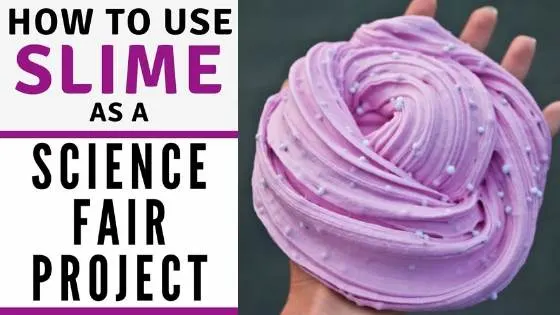

Are you looking to try a slime science project? Homemade slime is becoming an increasingly popular thing, and rightfully so. Slime provides many learning opportunities across multiple subjects, including tactile sensory play, science and chemical reactions, math and ratios, hands-on STEM/STEAM, problem-solving and more. Slime is a good example of a STEM activity.
Typically slime is thought to be a fun activity for younger kids, but there is much to be learned from this fun science activity for older kids too. Slime science is a fascinating thing and if you’re okay with a messy kitchen, you’re in for a day of fun-filled chemical reactions, creativity, and cause-and-effect reactions that even high school students will enjoy.
Using the scientific method, your students are well on their way to discovering the scientific wonders of slime.
Whether you’re looking for the perfect science fair project, an educational activity for your homeschool STEM curriculum, or you just want to have fun with your kids, we’re going to show you the step-by-step process for making slime with your kids.
This article may contain affiliate links. Please see our disclosure policy for more details.

Want a free STEM project to do with your kids? Click the button below to sign up to have an exclusive project guide sent to you so you can see exactly what to expect from our popular STEM Made Easy Digital Subscription.
Or read more about the other STEM Made Easy Digital Subscription here. Each month includes 5 STEM project guides along with step-by-step instructions, worksheets, and extra learning resources to make STEM fun and engaging for kids ages 3-19.
When I was in high school, I was considered a very good student. I found most of my classes to be simple and fun, with one exception: chemistry class. I got my first ever C in chemistry junior year, and to this day I still consider that to be one of the hardest classes I ever took. It’s no surprise that I always put off teaching chemistry to my own kids.
So what does this story have to do with slime? What’s so educational about slime anyhow?
The fact is, there is a science of slime. For one thing, slime is chemistry in motion.
Chemistry explains states of matter such as liquid, solid, and gas, and it also explains how these states of matters react under different conditions, especially the formation of new substances.
Slime is a non-Newtonian fluid, meaning it does not conform to the standard rules of fluid dynamics. Unlike water, which has a constant viscosity, slime can change its viscosity in response to stress. This property is what makes slime so interesting to play with and experiment on.
Slime science projects feature an endothermic reaction, meaning it absorbs heat (energy) rather than giving it off. This explains why slime gets colder over time. Then, depending on the recipe you use, certain ingredients change the molecular makeup, also known as cross-linking. Your student can use the scientific method to test which slime recipes and ingredients cause which chemical reactions.
Slime also has unique properties when it comes to its behavior under stress. When slime is stretched or pulled slowly, the polymer chains slide past each other, making the slime more fluid-like. However, when the slime is rapidly stretched or hit with force, the polymer chains become entangled and the slime becomes more solid-like.
Other chemistry concepts that making slime involves are:
Talk about fun science activity! It’s no wonder people all over are using this concept as a slime science fair project idea.

Slime is a fascinating substance that makes science for kids fun and engaging. This simple science activity contains some fascinating information.
You can teach your children why glue stays liquid (because it is a polymer made up of identical long strand molecules, called monomers) until a borate ion ingredient is added to the mixture (connecting the long strand molecules together). Throughout the mixing process, these ingredients begin to form a thick, rubbery type substance (eventually becoming slime).
Slime is also a unique substance that can be considered a solid and a liquid (known as a non-newtonian fluid). You can even experiment with making it more or less thick and sticky (viscous/viscosity) by adding foam beads.
The possibilities are almost endless.
Use these easy slime recipes and experiment with the elements of slime. Make sure you take good notes so you can use what you learn in your next science project! Consider testing out multiple basic slime recipes, or perhaps multiple variants of the same recipe, during your science project and see what happens when you combine different ingredients.
For example, in the Borax Slime recipe, what happens if you add less borax? Or more? How much borax would you need to add to turn your slime into a rubber ball? There are so many questions and possibilities to discover!
On that note, feel free to download these free, printable scientific method worksheets. Perfect for slime science fair projects or other at-home science experiments.

Tip: add 1 TSP and knead for 5 minutes, then add ½ TSP and continue kneading.
This mixture will be sticky but will be less sticky as you add more contact solution. Consider adding baby oil to your hands if it’s too sticky. Store in an airtight container for future play
Remember – borax is a soap (commonly used along with laundry detergent) and is toxic! Keep this in mind when using with young children.
***Consider adding glitter, food coloring, and foam beads to any of your slime mixtures to create different kinds of cool looking slime.
Although most basic slime recipes you’ll find here (and across the internet) are typically child-safe, there are a few safety and precaution tips we’d like to share.
For starters, an adult should always be in supervision of creating the slime. Adults should always be the ones handling any ingredients that are considered chemicals, such as borax powder or laundry detergent. Most slime projects are not suitable for children under the age of 4.
If you notice any type of skin irritation, discontinue making, using, and/or playing with slime immediately. In some cases, gloves can be worn while playing with slime. Slime should be played with in moderation and not played with for an extended amount of time. Most slimes are not edible (and none on this page are) so refrain from putting slime in any mouths.
If you are looking for slime recipes that are safe to eat (and perhaps even delicious!) check out this article on edible slime recipes and other edible science experiments.

With your slime education and recipe, you are now ready to use your slime concoction for a science fair project!
There are many ways you can do this; however, you can’t go wrong with presenting it through the scientific method. The way you work through this method can be what you show bystanders at your science fair.
Navigate through the following prompts to create a project worth remembering:
After you’ve finished conducting your slime science experiments, you’ll need to dispose of any leftover slime properly. The following are a few tips for safely disposing of slime:
Sometimes, your slime science experiments may not turn out the way you expected. Here are some common issues and how to troubleshoot them:

If you liked this edible STEM activity, you are going to love the STEM Made Easy Digital Subscription. Each month, you’ll receive 5 fully-planned STEM project guides along with worksheets and instructions for how to make them fun and engaging for kids ages 3-19. Check it out now!
What kind of slime will you be making? Let us know in the comments below!
Charlene Hess is the founder of Hess UnAcademy. She spent many years teaching before she had her own kids. She now has 8 kids of her own, whom she has been homeschooled for over a decade.
She has now moved on from Hess UnAcademy to focus on her family and her new site, Secret Life of Homesteaders.
Latest posts by Charlene Hess (see all)